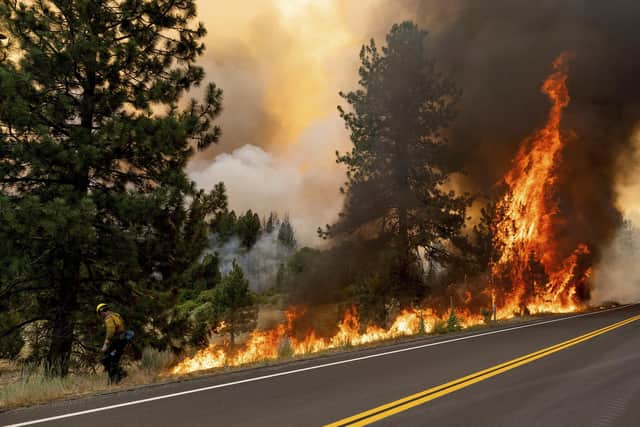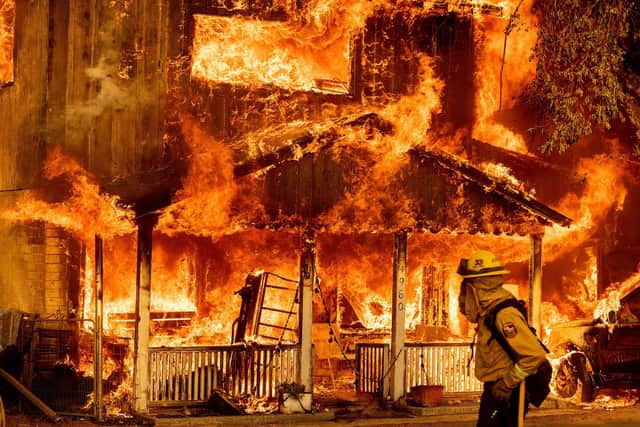Insight: Could Canada's searing heatwave be a sign of the climate change to come in Scotland?
Canada experienced its hottest day ever at the end of last month, when thermometers in the village of Lytton reached 49.6C – significantly above the previous national record of 45C.
Shortly after setting the record, Lytton was largely destroyed in a massive wildfire. Figures show nearly 500 sudden deaths occurred in the Canadian province of British Columbia that week, while hospitals saw a massive surge in heat-related health problems.
Advertisement
Hide AdAdvertisement
Hide AdThe excessive heat has also seen power lines melt, motorways buckle and other infrastructure disrupted. Shellfish was even cooked on shorelines.


This weekend the region was bracing itself for the fourth such heatwave in five weeks, as dangerous wildfires continue to rage across the drought-ravaged landscape. It will be centred on an area of the Rocky Mountains in the US and up into Canada, with temperatures close to 17C above the average for this time of year.
A rare ‘heat dome’, where a combination of atmospheric conditions sees high pressure trapping warmth, was blamed for the unprecedented high temperatures which hit in Canada.
However, scientists from the World Weather Attribution group have said the hot spell would have been “virtually impossible” without the influence of human-caused global warming. They concluded climate change made the heatwave hotter and at least 150 times more likely to happen.
“What we are seeing is unprecedented,” said the research team’s Friederike Otto, of the Environmental Change Institute at Oxford University.


“You’re not supposed to break records by four or five degrees Celsius. This is such an exceptional event that we can’t rule out the possibility that we’re experiencing heat extremes today that we only expected to come at higher levels of global warming.”
Currently, the highest officially registered temperature is 56.7C, recorded in California’s aptly named Death Valley in 1913, but at least 23 countries have logged maximum temperatures of 50C or above.
The world’s hottest day so far this year was in Kuwait, where thermometers peaked at 53.2C on June 22.
Advertisement
Hide AdAdvertisement
Hide AdMeanwhile, Scotland’s top temperature is more than 20C cooler – a comparatively tepid 32.9C, registered in the Borders village of Greycrook back in 2003. The UK’s record temperature was set in Cambridge in July 2019, when the mercury hit 38.7C.


Across the planet, the past decade has seen the highest average temperatures since records began. The most recent years have been the warmest of all, with 2020 and 2016 tied in first place, followed by 2019. Again, this accelerating heating up is attributed to human-induced climate change.
So what is climate change?
Climate and weather are not the same thing, although they are interlinked.
Climate is measured over a long period of time and defined by a set of average seasonal conditions such as rainfall, temperature and wind speed, which vary from place to place. Weather, on the other hand, can change from day to day and year to year – or in Scotland, minute to minute.
The average global temperature is currently around 15C, but has been considerably higher and lower in the past. There have always been natural fluctuations in the climate, but temperatures have been rising more rapidly over the past 150 years than in many earlier times.
This is caused by the greenhouse effect, which describes how the earth's atmosphere traps solar radiation.
Simply put, light from the sun passes through the atmosphere and is absorbed by the planet's surface, warming it. Greenhouse gases such as carbon dioxide act like a blanket, trapping heat near the surface and raising ground and air temperatures. This is a natural process that warms the planet and allows life to survive.
However, human activities such as burning fossil fuels, cutting down forests, intensive farming and pollution from industry and traffic are adding huge quantities of extra emissions to those that occur naturally, ramping up the rate of warming.
Advertisement
Hide AdAdvertisement
Hide AdEffects of climate change include melting ice sheets, rising sea levels, ocean acidification and increasingly frequent extreme weather events such as heatwaves, droughts and heavy rain.
Scientists have agreed that warming should be kept below 2C – ideally no more than 1.5C – by the end of the century to avoid catastrophic and irreversible climate change.
Temperature rises vary from region to region, but the global average shows the planet has already warmed by more than 1C since the industrial revolution and is on course for temperature rises of 3C or even 5C by 2100 if action is not taken to curb it.
Could Scotland and the UK see the kind of heatwave experienced in the Pacific northwest last month?
The answer is not straightforward.
Although average temperatures across the globe are rising faster than ever before, it’s unlikely that Scots will be faced with 50C heat any time soon.
However, as Grahame Madge, a spokesman for the Met Office, explains, weather is “almost infinitely variable” and climate change can see the unexpected become more commonplace.
“Just because we’ve got, in some cases, hundreds of years of weather observations in the UK, that doesn’t necessarily mean we have witnessed everything the weather is able to throw at us,” he warns.
“Going forward we know that levels of greenhouse gases, principally carbon dioxide, in the atmosphere are not going to stabilise at current concentrations – they’re going to rise.
Advertisement
Hide AdAdvertisement
Hide Ad"So these extreme events become ever more likely in future because we’re loading the atmosphere with more and more greenhouse gases, which drive the increasing frequency and severity of these sorts of events.”
Projections done for the UK show a similar pattern, he says, but do not indicate temperature values as high as Canada’s 49.6C – which is more than 10C above the UK’s highest recorded temperature.
“Meteorologists have been looking at the Canada event and it would clearly always have been extreme, even without the loading of the greenhouse gases, but it wouldn’t necessarily have been record-breaking,” he says.
What humanity has done is effectively moved the baseline.
“The thing to understand about weather is it’s almost infinitely variable and you can see extremes of weather under any scenario. But when you increase greenhouse gas concentrations in the atmosphere, then events which would have been hot get that global warming dividend added to them so they become more intense and more frequent.”
This ‘dividend’ doesn’t necessarily alter the character of warm, cool, wet or dry spells, but it does add or take away from their severity.
“The converse of the heatwave is when we get chilling temperatures coming from the Arctic, an Arctic blast,” Mr Madge says.
“But the feeling now is that those aren’t quite as extreme as they used to be because of the warming that’s taking place in the Arctic.
“So when you start adding a degree or even several degrees to those spikes and troughs then you can start to see the shift in our weather patterns, which means extremes of weather in the UK related to high temperature outnumber low temperature extremes by about nine to one.”
Advertisement
Hide AdAdvertisement
Hide AdProfessor Gabi Hegerl, personal chair of climate system science at the University of Edinburgh’s School of GeoSciences, has been involved in a wide range of climate and weather research during her career.
She explains that extreme weather events are very difficult to predict due to their very nature.
Statistical modelling using data available would have concluded that the heatwave in the Pacific northwest, where previous temperature records were exceeded by more than 5C – and around 10C in some places – was “not possible”, she says.
There’s a chance the same sort of unusual scenario could happen in Scotland, she admits, but conditions would have to be “exactly right” and temperatures would very rarely rise above 40C.
Climate change in Scotland
Back in February wildfires tore through parts of the Western Isles, despite much of the country being blanketed with snow.
‘Extreme' wildfire warnings were issued at the time for much of Scotland's west coast and islands due to “tinder-dry” conditions.
The dry spring saw similar warnings put in place in April and May for other parts of Scotland.
Also on the west coast, a major fire swept across the hillsides near the remote village of Achintraid in the Kishorn area, threatening homes, in early May.
Advertisement
Hide AdAdvertisement
Hide AdMost of the UK is currently enjoying a warm sunny spell, but today is the first day the mercury is expected to rise above 30C – a marker usually achieved in June. Health warnings have been issued.
But rather than sky-rocketing temperatures, the biggest worry in Scotland is probably increasingly erratic, heavy and prolonged rainfall.
Warmer temperatures allow more moisture to be carried in the atmosphere, raising the risk of sudden torrential downpours in summer, which can cause major flooding.
Such scenes were witnessed in Edinburgh earlier this month, when half of July’s usual rainfall fell in just one hour. Streets were deluged, damaging homes and businesses and causing major travel disruption.
Glasgow was inundated after a series of flash floods sparked by thunderstorms in late July and early August 2002, while the north-eastern town of Ballater suffered its worst flooding in 200 years in December 2015 when the River Dee burst its banks after Storm Frank.
Record rainfall has hit western Europe in the past few days, causing devastating floods and claiming dozens of lives in parts of Germany and Belgium. The Netherlands has also been badly hit.
Climate change is being blamed for causing the extreme weather.
Another potential concern could be heightened mugginess in a warmer climate.
Advertisement
Hide AdAdvertisement
Hide AdA new study warns of the dangers of the little-known ‘wet bulb temperature’, which measures heat and humidity. At wet bulb temperatures of 32C even fit, acclimatised people can’t work because their bodies are unable to shed heat through sweat evaporation – at 35C, even those sitting in the shade will die within hours.
Climate change is making these sorts of wet bulb temperatures increasingly likely, with parts of the Middle East and Pakistan among those already experiencing dangerously hot and humid conditions.
Why is Glasgow important?
At least for two reasons. Firstly, it is important because of future-proofing efforts being undertaken in collaboration with the Clyde partnership.
The city is one of many at risk of flooding and other climate change impacts. Now developers and climate scientists are collaborating to help plan a cityscape that will be fit for the future.
Dr Tyrone Dunbar, manager of the Urban Climate Services team at the Met Office, said: “Climate projections show that many places are likely to be severely impacted by climate change, and the greater Clyde area is no exception.
“Even if we stopped emissions of greenhouse gases tomorrow, we would continue to see increasing impacts in the near-term and so climate adaptation is crucial.
“Urban coastal communities, such as Glasgow, face considerable challenges from extreme heat, shifting rainfall patterns and sea level rise, which can lead to major harm to vulnerable communities as well as damage to people’s health, homes and livelihoods.
“These impacts underline the importance of preparing our cities to be resilient not only in the face of future climate change, but of the changed climate we are living in today.
Advertisement
Hide AdAdvertisement
Hide Ad“We are working with city councils, urban developers and emergency responders around the UK so that they can use climate projections to help make our cities safer and better to live in.
“A particular challenge is the risk of overheating in buildings, which could increase substantially in future with major impacts on people’s health, especially the already vulnerable. We hope that new homes built today will still be standing in 100 years’ time and they still need to be liveable in a much warmer climate.”
The second is Glasgow’s role as host of the United Nations climate summit COP26, which is due to be held there in November.
The event is being hailed as the most crucial international meeting on climate change since the landmark Paris Agreement was set out in 2015, with the 200 countries that have signed up the accord due to report how the emissions cuts necessary to keep global warming below the 2C threshold will be achieved.
Prof Hegerl said: “A lot of people are now looking at what is the difference between 1.5C warming, which we are quite close to, or 2C or 3C. Particularly in hot extremes you see a huge difference in the impacts.
“We need to stay on a path to keep the overall warming low, but there is no question that global warming is already here. We have warmed globally by more than 1C so we have to adapt to the changes we already see.
“We have to think about heat in that context. Particularly we have to look at how we plan infrastructure, how we plan urban rainwater treatment.
"We have to realise also that the last 50 years is not a good measure of what’s going to happen in the future. We really have to account for an increase in extreme rainfall, for example. We have to plan forward, as is already being done in some places for sea level.
Advertisement
Hide AdAdvertisement
Hide Ad“We have to really work hard on adapting to climate change and making sure that we are ready for the extremes it will bring.
“COP is extremely important and I really hope, and for the sake of our children, that we will see something at the conference that really has teeth.”
Members of an international civil society group working for climate just ahead of the UN climate summit say the chaos unfolding across the globe is proof that “no warming is safe”.
Asad Rehman, of the COP26 Coalition, said: “Deadly floods in Germany, famines in Madagascar, fires and heatwaves in North America, and the Amazon now emitting more carbon dioxide than it absorbs. All this chaos at just 1.2C warming.
“This is one more warning that no warming is safe, and deadly for many. To prevent catastrophic climate change, we must limit temperatures to below 1.5C – and that needs real-zero 2030 targets for the UK and other rich countries, and financial flows of trillions to those most affected, now.”
Adapt to survive
Climate change has been described as the biggest challenge ever to face mankind. And this is no exaggeration.
Experts agree there will be major consequences if temperatures are allowed to spiral out of control and big efforts must be made to limit warming. But we will also have to transform the way we live to accommodate the new normal and safeguard lives.
A new study by the Met Office has examined how high-impact weather in the UK such as extremely hot days, heavy rainfall and very cold conditions could be affected at different levels of global warming.
Advertisement
Hide AdAdvertisement
Hide AdIt found the number of extremely hot days in the UK could increase four-fold. In Scotland the number of days where temperatures exceed 25C would rise from around two a year now to six days under 2C of warming and 13 days under 4C of warming, posing greater risk to human health from extreme heat.
At the same time the number of days of high-impact heavy rainfall could increase significantly, with some Scottish regions more acutely affected.
The number of days with sub-zero temperatures are likely to become less frequent, dropping from around 68 days a year to 45 days under 2C of warming and just 15 days under 4C of warming.
“We cannot totally prevent climate change,” according to Mr Madge.
“We’re already in it. It’s happening now. We can hopefully prevent the most severe impacts, but we need to recognise that we must adapt. We cannot evade it completely. Adaptation is key.
“It’s not a case of if. Climate change is already here. We’re living it now.”
He added: “The world has warmed by about 1C since the industrial revolution. We are also committed to further warming, so future climate change is inevitable, with likely impacts being more intense heatwaves, droughts and extreme rainfall events.
“However, our studies have shown that the greatest impacts occur under the highest levels of warming, so that should send a strong signal to delegates attending this year’s climate conference in Glasgow to agree to measures which will constrict climate change as much as possible.”
A message from the Editor:
Thank you for reading this article. We’re more reliant on your support than ever as the shift in consumer habits brought about by coronavirus impacts our advertisers.
If you haven’t already, please consider supporting our trusted, fact-checked journalism by taking out a digital subscription.
Comments
Want to join the conversation? Please or to comment on this article.
